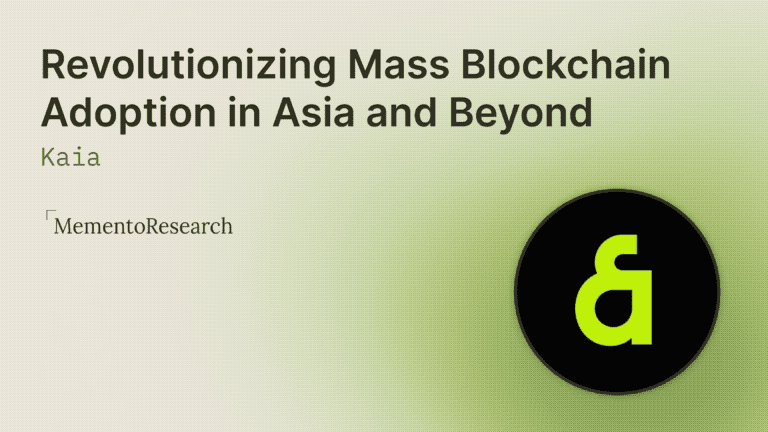Web3 adoption has grown exponentially in recent years. Despite the explosive innovation in blockchain infrastructure, Web3 still struggles with one key hurdle: mainstream user adoption. While wallets, Dapps, and DeFi protocols have advanced rapidly, the average user remains distant from Web3’s benefits—due largely to friction-heavy onboarding, poor UX, and lack of daily relevance.
To bridge this gap, the next frontier isn’t just better infrastructure; It’s embedding Web3 directly into platforms people already use and trust. And in Asia, nothing is more ubiquitous or culturally embedded than mobile messaging apps.
The Untapped Market Opportunity: Mobile Messaging Users
“In 2023, the smartphone adoption rate across the Asia-Pacific region reached 78 percent, marking an increase from 64 percent in 2019. By 2030, smartphone adoption in APAC was projected to reach over 90 percent.” – Statistica 2024
Mobile Messaging: A Ubiquitous Digital Touchpoint in Asia
Asia is witnessing rapid digital transformation, and at the heart of this shift lies the explosive growth of mobile messaging applications. With projections estimating a 90% adoption rate by 2030 and a global user base reaching 3.51 billion, messaging apps are becoming the most widely used digital entry points. This scale presents an enormous, largely untapped opportunity for onboarding the next generation of Web3 users.
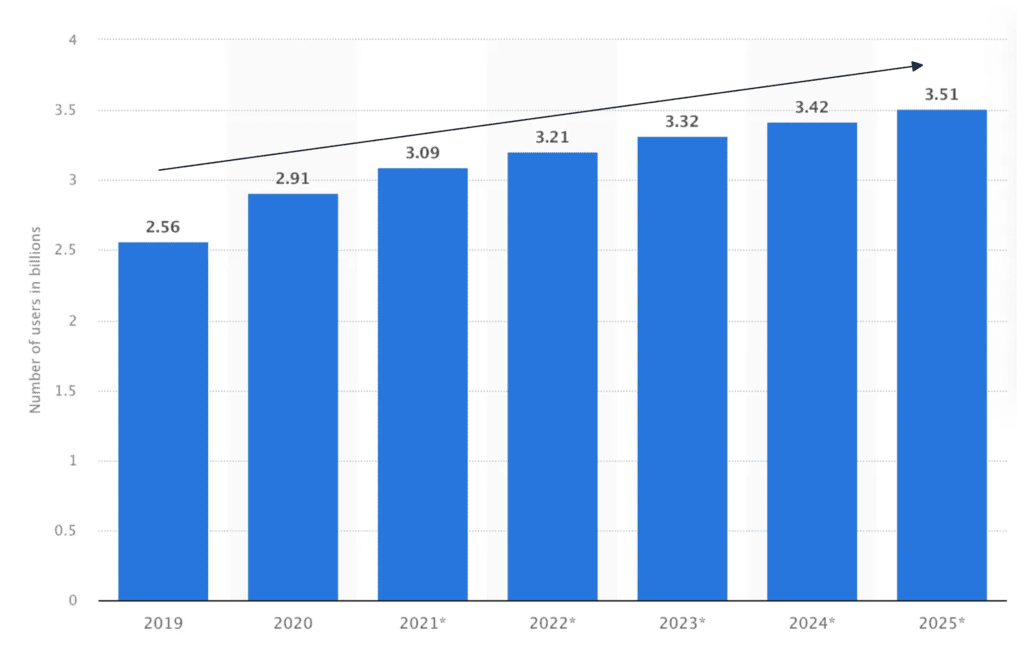
Number of mobile messaging users worldwide growth – Source: Statistica 2025
Messaging applications are no longer just tools for conversation—they’ve evolved into all-in-one lifestyle platforms, hosting services like payments, shopping, ride-hailing, gaming, and digital content. This growing utility makes them the ideal on-ramp for Web3 adoption, especially when users are onboarded through familiar, frictionless experiences.
From Chats to Ecosystems: The Evolution of Messaging Apps

2024 Social Media Landscape – Source: DataReportal
The evolution of apps like LINE in Japan, Thailand, and Taiwan plus KakaoTalk in Korea underscores a clear trend: messaging applications are transforming into lifestyle superapps. By integrating a wide suite of services—from digital banking and loyalty programs to content delivery—they capture users across multiple touch-points, increasing engagement and stickiness.
These all-in-one platforms are not only culturally embedded in their respective markets but also trusted by hundreds of millions of users across all age groups, making them prime channels for Web3 integration with minimal friction. The integration of blockchain-powered features into these familiar environments creates a smooth transition for Web2 users into Web3 ecosystems.
Kaia’s Thesis: The Right Infrastructure, The Right Go-to-Market Strategy

‘Kaia, A Familiar gateway to the brave new Web3 world’ – Source: Kaia
Kaia sits at the convergence of two defining trends: the rise of messaging super-apps and the increasing demand for seamless Web3 access. Born from the unification of two major blockchain initiatives—Klaytn (by Kakao) and Finschia (by LINE Tech Plus)—Kaia brings together deep technical infrastructure and unparalleled distribution reach.
With this foundation, Kaia offers more than just blockchain access—it delivers a familiar, frictionless interface that lowers onboarding barriers and enhances user trust. This enables seamless Web3-native experiences directly within apps used by hundreds of millions. This gives Kaia a first-mover advantage in embedding Web3 services—such as wallets, NFTs, DeFi, and mini Dapps—into platforms where success has been demonstrated from healthy daily usage and monetization.
Kaia isn’t just another blockchain; It’s the most user-ready, distribution-advantaged, and retail-friendly Web3 platform interwoven directly into Asia’s most-used lifestyle apps.
Report Summary
Kaia is uniquely positioned to catalyze mass Web3 adoption across Asia and beyond. With a high-performance blockchain infrastructure, direct distribution via dominant messaging platforms, and a strategic funding model, Kaia presents a compelling foundation for both developers and users.
This report will cover:
- Value Proposition & Technology Novelty: The combination of strategic distribution advantages of Kaia alongside with an overview of it’s technical architecture that make it ideal for seamless, scalable foundation for mainstream Web3 applications.
- Ecosystem Growth & Adoption Flywheel: A look into Kaia’s expanding presence across key verticals such as DeFi, RWA, and gaming, along with ecosystem initiatives designed to bootstrap usage and developer activity.
- Tokenomics & Funding Mechanism: A breakdown of the $KAIA token model and Kaia’s long-term ecosystem and infrastructure support through its treasury and incentive programs.
Kaia: Asia’s Next-Generational Mass Adopted Blockchain
LINE x Kakao: The SuperApp Leverage Thesis
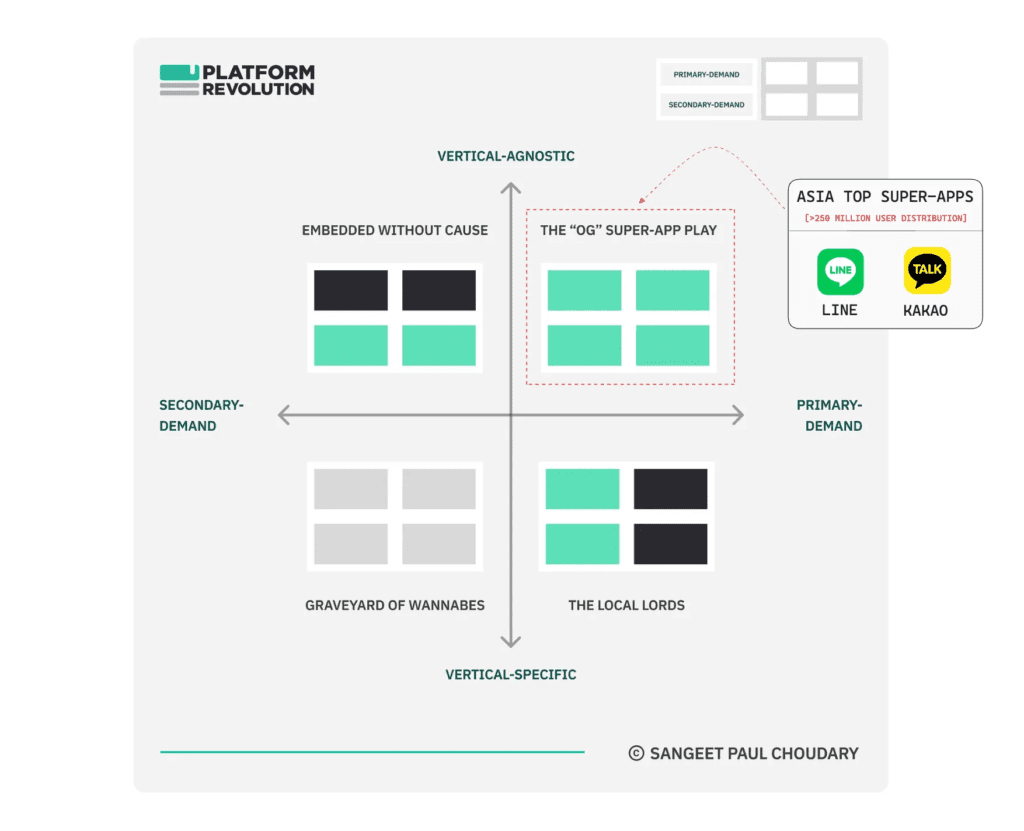
Superapp Platform Quadrant Classification – Source: “Why your super-app strategy will (most likely) fail” by Sangeet Paul Choudary
By capturing both user attention and transaction flow, they function as lifestyle operating system layers across all age groups. Deeply embedded in the daily routines of over 250 million users, they consolidate everything from messaging and payments to commerce, content, gaming, and digital identity under one trusted interface.
The SuperApp’s Utility Compounded Effect
Crucially, these platforms benefit from rare, entrenched distribution and self-reinforcing network effects. Each added-on service or vertical not only deepens engagement but also compounds utility across the entire ecosystem due to the significantly lower switching cost involved. Users benefit from seamless service integration; developers gain instant distribution. The result is extremely high stickiness and near-zero switching intent—a feat only a few apps globally (like WeChat or Telegram) have achieved. As a result, their dominance as all-in-one applications is not just sustained, but continuously amplified.
On True Crypto Adoption
Most so-called “consumer chains” tout mass adoption but lack one thing: distribution. They must compete for attention, build new funnels, and re-educate users. Kaia doesn’t.
Kaia, by contrast, faces none of these frictions. Natively embedded within LINE and Kakao, it gains immediate access to a vast, high-frequency user base without the need for external distribution or re-education. This structural advantage—an exclusive Web3 channel inside Asia’s most dominant superapps—positions Kaia to deliver seamless access to Web3 services and potentially transform Asia’s most entrenched super-apps into frictionless gateways for mainstream Web3 adoption.
A High-Performance Modular Blockchain for Real-World Adoption
Kaia emerges from the strategic merger of two established blockchains—Klaytn (by Kakao) and Finschia (by LINE Tech Plus). This strategic alliance seeks to unite the technical capabilities and distribution power of Asia’s most dominant messaging platforms. Purpose-built for scalability, cost-efficiency, and developer usability, Kaia is engineered to support high-volume, consumer-facing Web3 applications across payments, gaming, and social finance.
Kaia Technical Highlights
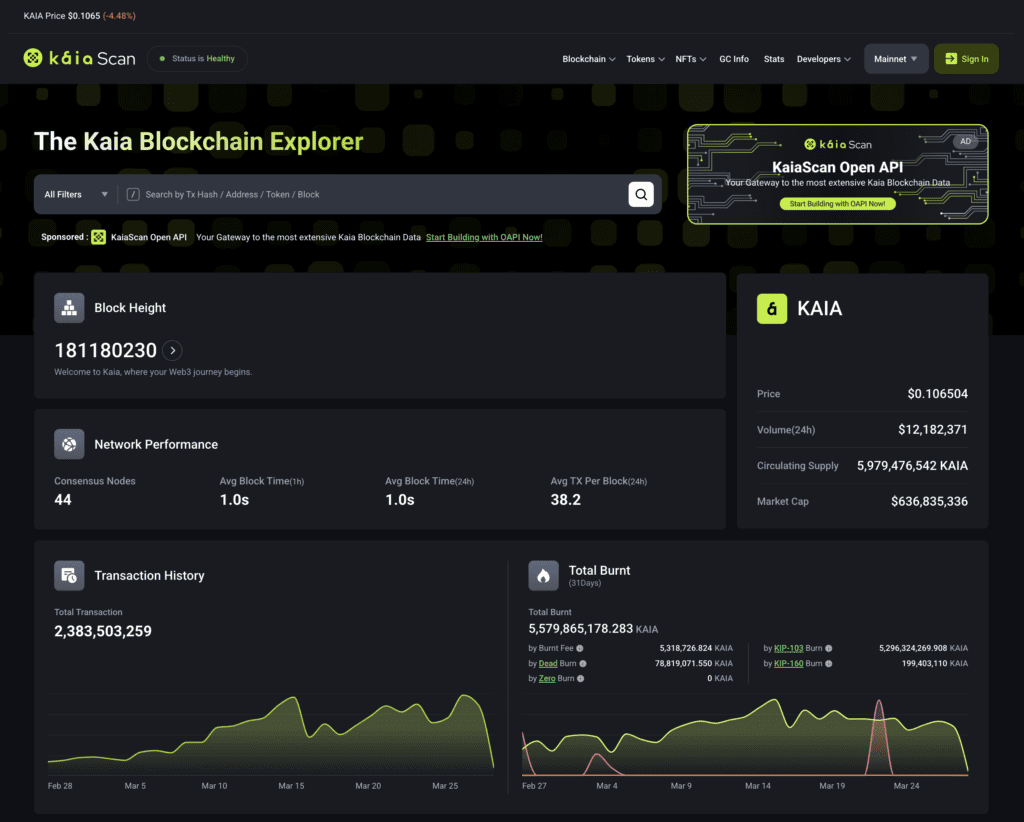
Kaia Blockchain Explorer – Source: Kaiascan
Kaia’s performance-oriented blockchain infrastructure is designed to meet the demands of mainstream adoption:
- 1-second block generation and instant finality, delivering low-latency transaction experiences.
- Up to 4,000 transactions per second (TPS), supporting enterprise-grade throughput.
- Ultra-low gas fees, approximately 1/100th the cost of Ethereum, ensuring sustainable user interactions at scale.
These core specifications position Kaia as an optimal foundation for high-frequency Dapps, particularly in mobile-centric markets where speed and affordability are essential.
The Superior Developer Experience
Kaia Virtual Machine (KVM): Familiar for Developers, Optimized for Scale
At the heart of Kaia’s smart contract execution is the Kaia Virtual Machine (KVM)—a fully EVM-equivalent environment supporting seamless Solidity-based contract deployment. KVM brings added performance benefits, including:
- Precompiled Contract Support: Custom opcodes with a fixed-fee model reduce gas consumption for computation-heavy logic.
- Developer-Friendly Framework: Full compatibility with existing Ethereum tooling (e.g. Hardhat, MetaMask, Remix), enabling fast migration and deployment with minimal friction.
This design meaningfully reduces both the knowledge barrier and cost of entry for developers—whether new or experienced—making Kaia a frictionless, scalable environment for building and deploying on-chain applications.
Developer-Centric Infrastructure & Tooling

Kaia SDK Documentation Overview – Source: Kaia Documentation
Kaia places a strong emphasis on developer experience, offering robust SDKs and wide-array of supporting libraries across different programming languages that simplify Web3 integration for Web2-native applications:
- Full SDK Support: Comprehensive toolkits for integrating Kaia with existing LINE and Kakao applications, enabling mini-Dapp development and feature expansion.
- Embedded Wallet Integration: Developer-ready wallet infrastructure to onboard users directly within messaging apps or browser environments.
- Unity WebGL Compatibility: Out-of-the-box support for gaming applications, enabling blockchain-backed functionality in familiar development stacks.
This streamlined development environment reduces time-to-market for builders while promoting ease of adoption across the Kaia ecosystem.
Kaia: Exclusive Web3 Dapp Portal Integration
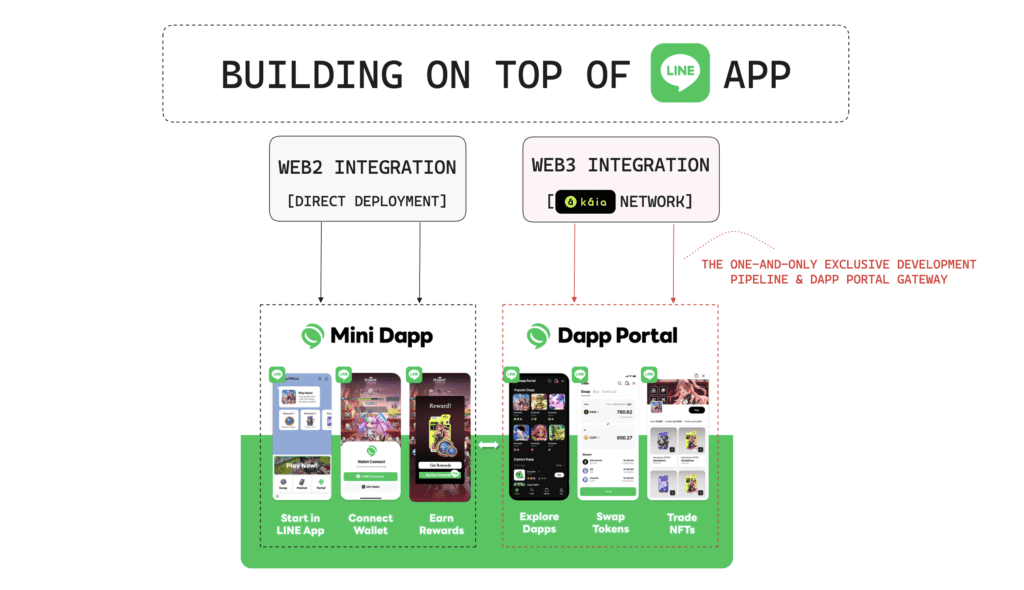
A key differentiator for Kaia lies in its exclusive partnership with LINE NEXT for Web3 mini-Dapp integration. While any blockchain can integrate with LINE’s Web2 mini-app SDK (open-source and intended for traditional app experiences), only Kaia has exclusive access to LINE’s Mini Dapp SDK and Dapp Portal.
This exclusivity allows Kaia developers to:
- Build native Web3 applications directly within LINE’s ecosystem, with access to features such as embedded wallets, blockchain-based authentication, and token interactions.
- Deploy to a dedicated Web3 Dapp portal accessible to LINE’s massive user base providing Dapps with visibility, credibility, and seamless user access within the super-app environment.
This not only ensures a privileged distribution channel to millions of LINE users but also creates a defensible advantage for Kaia Dapps seeking adoption within one of Asia’s most widely used communication platforms. As the only channel powering Web3 experiences inside LINE, this positions Kaia as a key onramp for the next wave of mass adoption.
Seamless Development Workflow: The Comprehensive Stack Integration
The integration of Mini Dapps on LINE with Kaia further offers a powerful approach to lowering onboarding friction and streamlining Web3 development.
This is achieved via an exclusive gateway accessing a vast combined distribution of over 200 million active user distribution on LINE via embedding Dapp directly. Developers eliminate the typical switching cost associated with Web3 adoption, allowing users to access blockchain functionality within a familiar interface. This all-in-one experience not only significantly enhances accessibility, but also improves user engagement and retention.
Mini Dapps on LINE Architecture
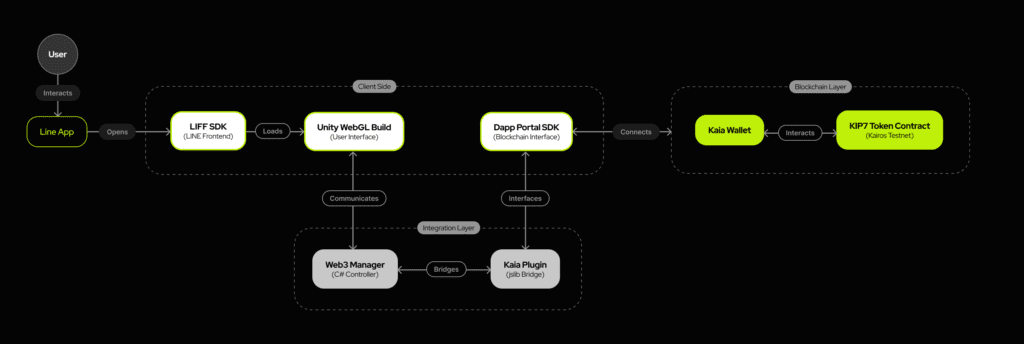
Kaia: Mini Dapps on LINE – Source: Kaia Documentation
On the development side, Kaia’s infrastructure simplifies the entire stack through a comprehensive SDK, enabling seamless connectivity between Mini Dapps on LINE and the Kaia blockchain. This is achieved via an end-to-end development of Mini Dapps on LINE, enabling developers to build Web3 experiences with ease and efficiency. The integration is optimized across three core layers:
- Client Layer: Powered by Unity WebGL and LINE’s front-end framework, allowing developers to deliver immersive, native-like app experiences directly within the LINE platform.
- Blockchain Layer: Built on Kaia’s EVM-equivalent, high-performance, and low-cost blockchain which ensures scalable and gas-efficient interactions.
- Integration Layer: A comprehensive SDK and Kaia Wallet infrastructure provide the necessary tools for seamless wallet connectivity, smart contract interactions, and integration of Web3 functionalities into existing Web2 platforms.
This layered architecture empowers developers to rapidly build and deploy Mini Dapps tailored for gaming, social, and commerce applications all without compromising usability, cost-efficiency, or speed-to-market.
Strategic Advantage Through Embedded Distribution via Mini Dapps
Kaia’s core advantage lies in its deep integration with Kakaotalk and LINE, giving it immediate access to a user base of over 250 million. This unique embedded distribution model allows Kaia to meet users where they already are, offering intuitive access to Web3 services like wallets, NFTs, and DeFi through the same messaging platforms they use every day.
This approach effectively bootstraps adoption, enabling faster market penetration along the S-curve of technology adoption.
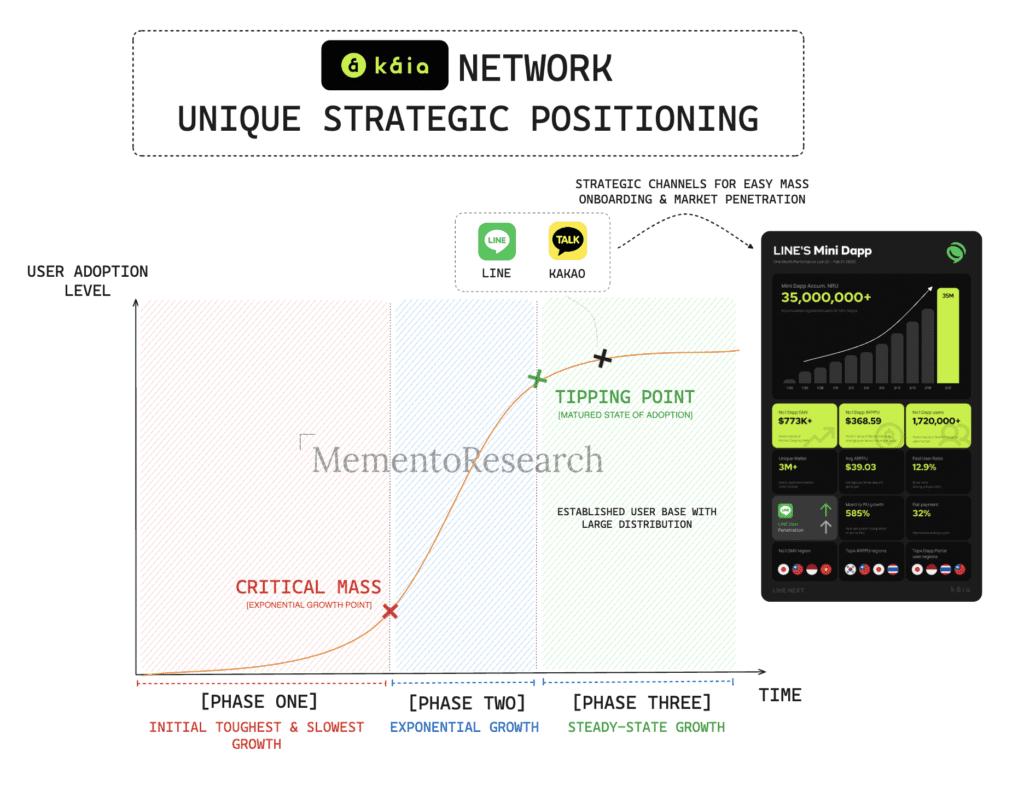
Visualisation of S-Curve Adoption Growth: Kaia
Rather than reinventing the user journey, Kaia capitalizes on trusted user habits, embedding decentralized infrastructure into everyday communication platforms. This not only positions Kaia as a first mover in driving Web3 adoption across Asia, but also allows it to bypass the typical cold-start problem—eliminating the need to independently build network effects from scratch.
By integrating at the point of user familiarity and scaling through trusted ecosystems, Kaia is well-positioned to reach critical mass faster, unlocking exponential growth potential and paving the path toward self-sustaining adoption and long-term ecosystem maturity.
Kaia Stellar Chain’s Growth

Kaia Chain Growth – Source: Kaia Foundation Dune Dashboard
Kaia Network has seen explosive growth, thanks to its deep integration with LINE Messenger—one of Asia’s most popular communication platforms. Through LINE’s Mini Dapp portal as part of the recent Kaia Wave campaign, the seamless gateway flow has onboarded 35.2 million cumulative Mini Dapp users wallets, demonstrating strong user penetration via familiar Web2 channels.
As a result, Kaia now ranks as the largest EVM blockchain by active wallets in the past week (April 2025), with average daily transactions up more than 20,000% to roughly 6.25 million count, growing exponentially over the months across a wide range of ecosystem Dapps.
In terms of monetization potential, Kaia saw nearly $4M in on-chain purchases (via $KAIA payments) with an impressive 13% Paying User Ratio with $481 Average Revenue Per Paying User (ARPPU) across the top 3 Dapps. This growth aligns with spending behaviour in Asia, where users lead global in-app purchase (IAP) trends—spending 40% more on average than users in other regions. With strong distribution, high engagement, and rising monetization potential, Kaia is positioning itself as a leading Web3 gateway for the Asian market.
TLDR: A Scalable, Developer-First Blockchain Built for Mass Adoption
Kaia is purpose-built to power the next wave of Web3 adoption in Asia. Emerging from the merger of Klaytn (by Kakao) and Finschia (by LINE Tech Plus), it combines high-throughput infrastructure, ultra-low fees, and full EVM compatibility with the unparalleled distribution of two of Asia’s largest messaging platforms.
- 1-second block times, 4,000 TPS, and lower gas costs enable scalable, real-world use cases.
- Deep integration with LINE and KakaoTalk unlocks access to 250M+ users, embedding Web3 into everyday apps.
- Developer-first tooling (Unity WebGL, SDKs, wallet infra) simplifies onboarding for Web2 teams building Web3 experiences.
- Explosive growth: 35M+ Mini Dapp users, 35.2M total wallets, 13% PUR with $481 APPRU, and now the largest EVM chain by activity.
- Positioned as the go-to chain for payments, social apps, gaming, and commerce—all with zero switching cost UX.
Together, these factors have fueled Kaia’s current success and accelerated its growth trajectory.
State of Kaia’s Ecosystem
State of Kaia’s Ecosystem: A Growing Multi-Sector Landscape
Kaia is rapidly evolving into a comprehensive Web3 hub, anchored by a multi-layered ecosystem that spans across the application layer, middleware, and core infrastructure. This strategic foundation enables Kaia to support a wide range of high-impact sectors and use cases, forming the building blocks for long-term utility and mass adoption.
Crucially, these pillars will be brought directly to LINE’s massive user base via Mini Dapps—offering seamless access to Web3 services through familiar interfaces and trusted distribution channels.
Kaia: Expansive Ecosystem
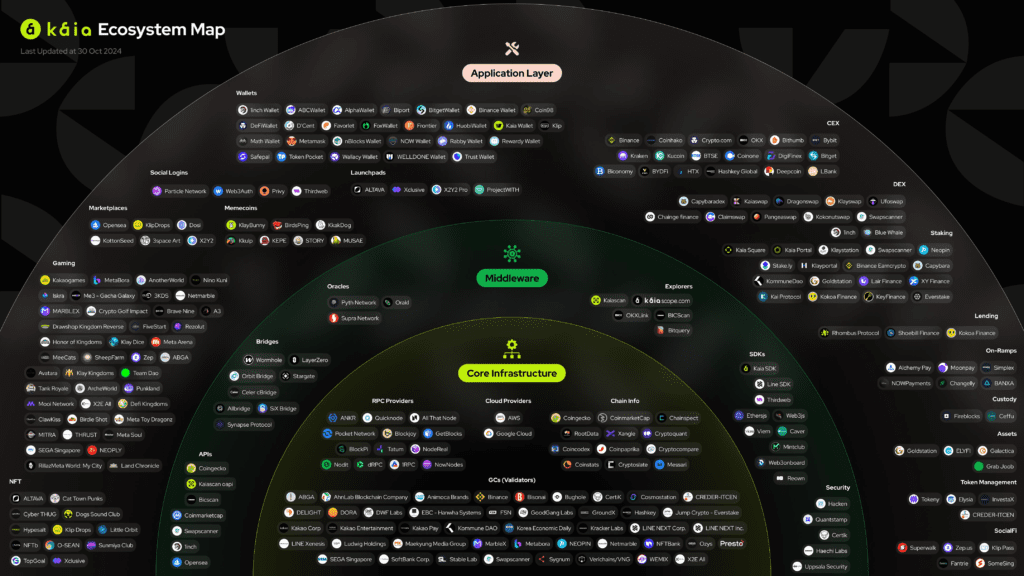
Kaia Ecosystem Map – Source: Kaia
Kaia is rapidly building a robust and diverse Web3 ecosystem, strategically spanning several high-impact verticals to foster long-term utility and adoption. As the network matures, its infrastructure is actively supporting the emergence of both foundational DeFi protocols and next-generation blockchain-native services—from Real World Assets (RWA) to gaming and mobile-first applications.
With active growth across categories such as:
- Mini Dapps: LINE-integrated, mobile-first applications enabling seamless onboarding for mainstream users.
- DeFi: Foundational primitives including DEXs, lending, liquid staking, and yield protocols.
- RWA: Tokenized real-world asset platforms that provide transparent, on-chain access to traditionally illiquid capital—bridging real-world value with composable, programmable DeFi liquidity.
- Gaming: Projects leveraging Unity WebGL and on-chain game economies for immersive user engagement.
- NFT & Meme: Cultural and community-driven verticals that fuel network engagement and virality.
- Social & Others: Messaging-integrated, socially embedded applications expanding Kaia’s lifestyle app reach.
Kaia places strong emphasis on fostering a vibrant, self-sustaining ecosystem where user activity, developer innovation, and infrastructure growth continuously reinforce one another across sectors in a highly composable environment.
DeFi on Kaia: The Financial Core Powering Kaia’s Ecosystem
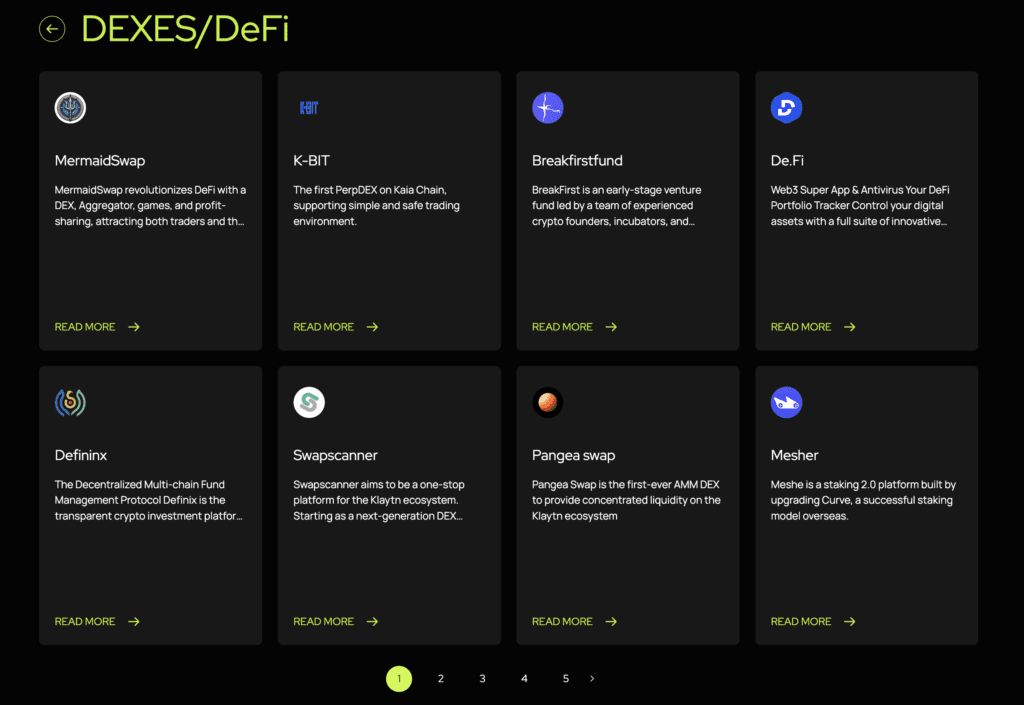
Kaia DeFi Ecosystem Showcase – Source: Kaia
Decentralized Exchanges (DEXs): The Trading Backbone
A healthy DeFi ecosystem begins with liquidity and accessibility—and Kaia is well-equipped in this regard with multiple decentralized exchanges:
- DragonSwap: A leading AMM-based DEX on Kaia, offering core swap and liquidity services for native KAIA pairs and other ecosystem tokens.
- Capybara Exchange: A newly emerging trading venue designed to provide intuitive UI/UX and incentivized liquidity pools for both native and bridged assets.
Together, these platforms facilitate seamless, low-cost trading while forming the essential liquidity layer for the ecosystem.
Liquid Staking: Unlocking Capital Efficiency for $KAIA
Staking infrastructure is vital for decentralization and capital productivity. Lair Finance serves as the liquid staking provider for $KAIA, enabling users to stake or restake their KAIA tokens while still maintaining liquidity exposure via representative tokens.
- $25M+ in TVL, with users earning an average yield of ~5.27% APY.
- Restaked $KAIA can be utilized across DeFi protocols, enhancing capital efficiency and fostering more composable DeFi interactions.
This unlocks a staking flywheel where users are rewarded for securing the network while being able to redeploy staked assets across Kaia-native DeFi.
Lending & CDP Infrastructure: Credit Markets & Stable Assets
Kaia Network’s lending vertical is steadily maturing, laying the foundation for a robust credit layer and stable asset infrastructure. Ecosystem diversity is on the rise, with platforms like Avalon Finance introducing crypto-collateralized stablecoins—such as Bitcoin-backed CDPs through $USDa.
These innovations reflect a broader shift within Kaia’s DeFi landscape toward unlocking utility across a wider range of crypto assets. By expanding stablecoin supply and deepening liquidity, they contribute to a more dynamic and composable financial stack. As borrowing demand and collateral variety grow, Kaia will also be well-positioned to power the next wave of capital-efficient DeFi use cases.
Native USDT Integration: Powering Scalable Stablecoin Payments on Kaia
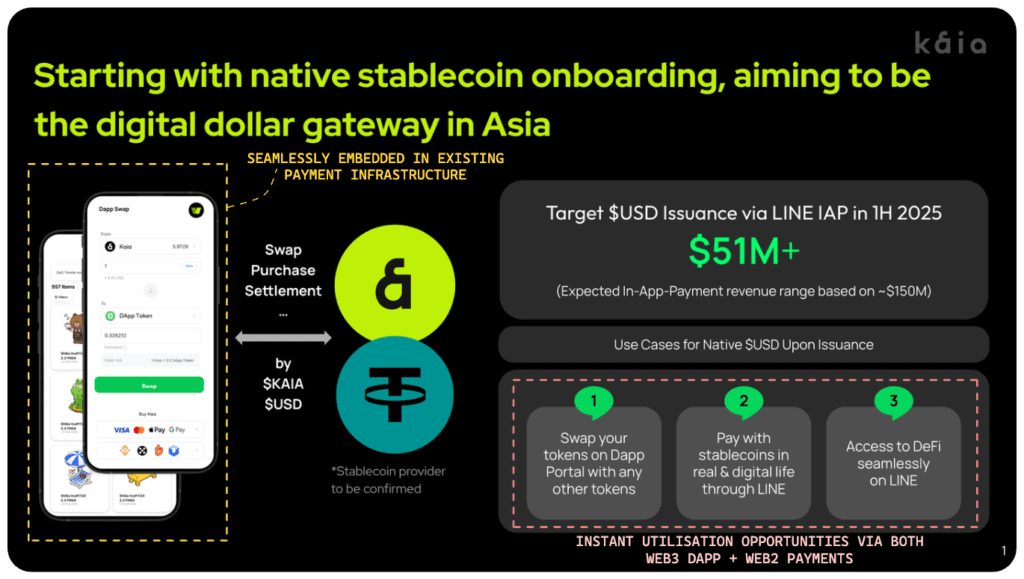
The Digital Dollar Gateway in Asia: Native Stablecoin Onboarding via Kaia – Source: Kaia
Kaia has reached a major milestone in its PayFi journey with the official launch of native $USDT by Tether, the world’s largest USD-backed stablecoin issuer. With over 400 million global users, Tether’s integration is a foundational step toward enabling scalable Web3 payments through Kaia’s uniquely embedded presence in Asia’s dominant superapps: LINE and Kakao.
Through this deployment:
- USDT is now natively accessible via LINE Messenger’s Web3 Dapp Portal, bringing stablecoin-powered transactions to the fingertips of mainstream users in an interface they already trust.
- Kaia is bridging traditional and decentralized finance, with plans to embed USDT across Web2 payment layers within LINE and Kakao’s existing infrastructure—offering frictionless access to stable assets for non-crypto-native users.
Looking ahead, Tether is working closely with Kaia ecosystem players, including LINE NEXT, to develop DeFi-native USDT utilities such as real-world yield, on/off ramps, and 1-click crypto swaps. These efforts not only deepen stablecoin liquidity but also reinforce Kaia’s positioning as a core enabler of the PayFi revolution where Web3 payments scale via trusted, embedded distribution rails.
Real World Assets (RWA): Bridging Physical and Digital Economies
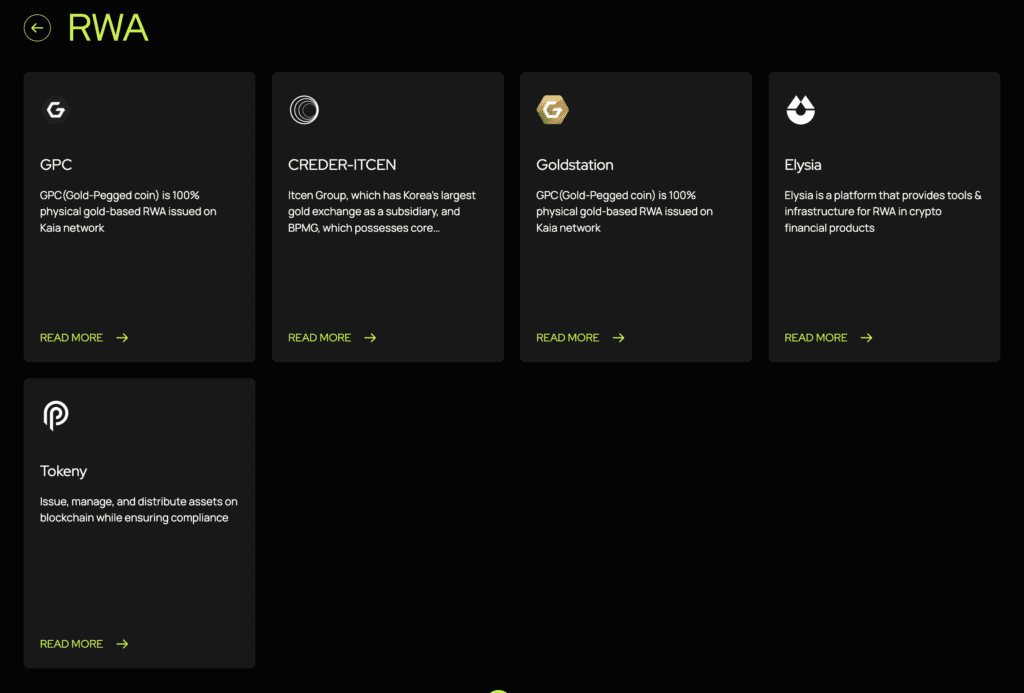
Kaia RWA Ecosystem Showcase – Source: Kaia
Kaia has positioned itself as an early leader in Asia’s RWA tokenization movement, building a robust foundation for connecting real-world capital with on-chain liquidity. Core initiatives like GPC, Goldstation, and CREDER-ITCEN are actively tokenizing assets such as gold, investment contracts, and physical goods—transforming them into verifiable, programmable financial instruments. These efforts not only enhance capital accessibility but also provide institutional-grade use cases aligned with regulatory developments across Asia.
Expanding RWA Verticals in Asia: Galactica x Kaia
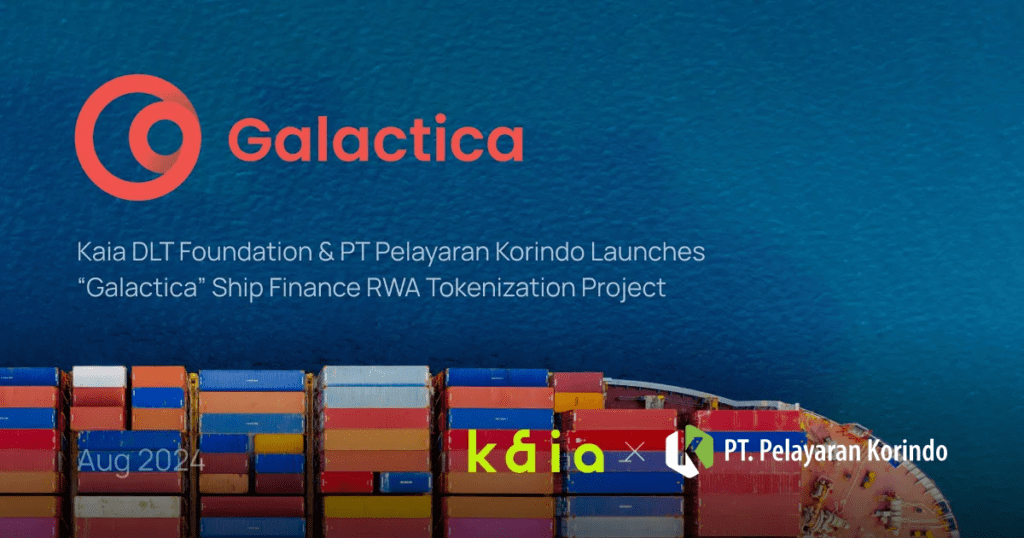
Galactica: Ship FInance RWA on Kaia – Source: Kaia Foundation Medium
Building on this momentum, Galactica—a joint venture between the Kaia Foundation and Indonesian logistics firm Pelayaran Korindo—represents Asia’s first ship-financing RWA project. Partnering with licensed platform InvestaX, Galactica enables fractionalized ownership of maritime assets, targeting Indonesia’s high-demand shipping industry. By digitizing ship acquisition through tokenized investment products, Galactica unlocks global capital flows into a traditionally illiquid sector while expanding Kaia’s RWA ecosystem into new verticals.
This marks a novel frontier in the RWA space—bringing tokenization to the shipping industry, a domain previously untouched by on-chain finance and largely absent from current RWA narratives.
This stands as a testament to how Kaia’s infrastructure can modernize legacy industries by unlocking real-world blockchain utility at scale.
Gaming: Tapping into Mobile-First Entertainment

Kaia Web3 Dapp Portal Explore Page – Source: Dapp Portal
Kaia’s competitive edge in Asia’s mobile-first culture makes gaming a high-potential vertical for growth. With seamless integrations into LINE and Kakao apps, Kaia enables:
- Popular Play-to-Earn gaming Dapps with the potential to be further integrated directly into messaging environment, targeting casual and social gaming users already embedded in LINE/Kakao to expand distribution
- Strategic partners such as NEOPLY and DeFi Realms are building engaging Web3-native games and metaverse applications, leveraging Kaia’s low-latency and cost-efficient transaction layer.
Given the mobile gaming dominance in markets like Korea and Japan, Kaia is set to become a launchpad for scalable, mobile-native blockchain games.
Mini Dapps: Embedded Through Familiar Interfaces

Kaia Portal: Mini Dapp Showcase – Source: Kaia
Currently, 42 live Mini Dapps are deployed on Kaia, spanning diverse verticals: from finance and gaming to NFTs and social utilities. These lightweight, seamlessly integrated apps have become a core engine of network activity, validating the strength of Kaia’s embedded distribution model.
By meeting users where they already are inside LINE and Kakao’s lifestyle apps, Kaia enables frictionless onboarding. This reinforces that distribution-first strategies are critical to scaling Web3 adoption at the consumer level that spurs a virtuous flywheel adoption cycle outlined next.
Flywheel Adoption Thesis: Strategic Distribution as a Catalyst for Network Growth
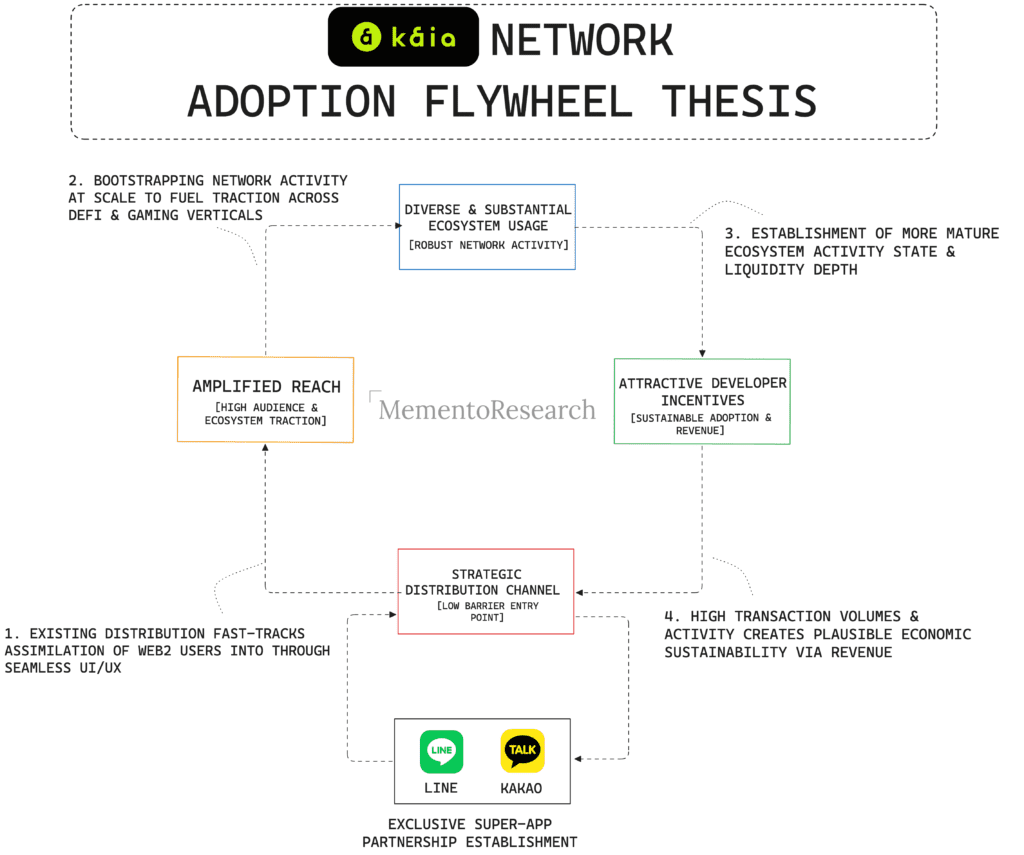
Visualisation of Kaia’s Adoption Flywheel Thesis
At the core of Kaia’s adoption strategy lies a powerful distribution advantage—its deep integration with Asia’s leading mobile messaging platforms, KakaoTalk and LINE. Together, these platforms boast a combined user base of hundreds of millions, offering Kaia unprecedented access to a highly active, mobile-native audience.
1. Strategic Distribution Enables Frictionless User Onboarding
Kaia’s embedded access within Kakao and LINE creates a low-barrier entry point for Web2 users into the Web3 world. Through intuitive UI/UX and wallet integrations, users are able to seamlessly interact with blockchain services, accelerating mainstream accessibility without the need for complex onboarding processes.
2. Amplified Reach Drives Early Traction
With access to such a massive and familiar communication channel, Kaia is positioned to bootstrap network activity at scale—fueling initial traction across its DeFi and gaming verticals. This early momentum not only attracts more users but also encourages projects and developers to build within the ecosystem.
3. Diverse Sector Coverage Enhances Stickiness
Kaia’s current DeFi stack covers key primitives—DEXs (DragonSwap, Capybara), lending (Avalon), liquid staking (Lair Finance), and RWAs (Galactica, Elysia, Tokeny). This ensures capital can be deployed productively, and that users remain within the ecosystem as more utility is unlocked.
4. Growth Support Fuels Builder Incentives
Complementing its user-side momentum is Kaia’s multi-pronged ecosystem funding support (KEF, KIF, IOK, and Kaia Wave) which offers targeted capital and technical assistance to builders. These funds reduce time-to-launch and de-risk innovation, further accelerating ecosystem development.
5. Increased Usage → Developer Incentives → More Apps
As usage scales, transaction volumes and user activity increase, creating sustainable economic incentives for developers. This forms a self-reinforcing loop: more applications lead to more utility, driving deeper engagement, and in turn attracting further adoption.
This strategic distribution advantage acts as the ignition point for Kaia’s adoption flywheel – unlocking a seamless, virtuous cycle of converting Web2 users into Web3 participants. As user activity compounds, it reinforces developer incentives, catalyzing a continuous cycle of growth, engagement, and sustainable ecosystem expansion.
Multi-pronged Ecosystem Support
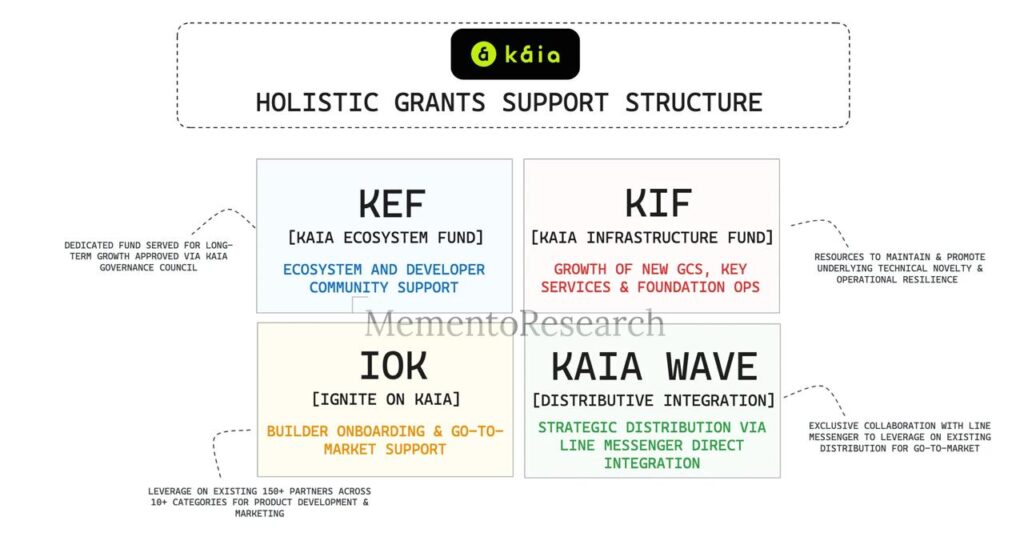
Kaia Grants Support: Comprehensive Pillars
To complement its go-to-market distribution edge, Kaia has designed a multi-layered support architecture that strategically targets all fronts of ecosystem development—from infrastructure and service onboarding to DeFi liquidity and builder support—laying the financial groundwork for long-term sustainability and compounding growth.
Kaia Ecosystem Fund (KEF): Accelerating Ecosystem Growth
Designed to directly incentivize ecosystem growth by supporting service development, developer engagement, and infrastructure expansion. Through initiatives like hackathons, academic partnerships, and DAO collaborations, KEF strengthens Kaia’s builder community while also funding high-utility services and essential ecosystem components. These targeted incentives not only accelerate adoption but also establish the foundation for long-term ecosystem sustainability by ensuring ongoing developer participation and value creation.
Kaia Infrastructure Fund (KIF): Strengthening Technical & Operational Foundations
This dedicated fund focuses on strengthening Kaia’s core blockchain infrastructure and operational resilience. By funding mainnet R&D, foundational services, and support for early-stage ecosystem partners, KIF ensures that the technical backbone of Kaia remains robust and scalable. Combined with operational funding for governance and liquidity, KIF plays a critical role in maintaining a sustainable and performant environment for developers and users as the ecosystem grows.
Ignite on Kaia (IOK): Builder-Centric Go-to-Market Support
IOK is Kaia’s flagship onboarding program aimed to streamline the entry of Dapp developers into the ecosystem by offering hands-on support across both technical and business functions. By allowing builders to focus solely on product development, IOK delegates critical components such as wallet integration, security tooling, oracles, APIs, marketing, and infrastructure to industry specialists. With a partner network of over 150+ service providers across 10+ categories, IOK provides a frictionless path to market readiness and scale, accelerating time-to-launch for high-potential projects while strengthening Kaia’s application layer from day one.
Kaia Wave: The Catalyst for Asia-Centric Web3 Expansion
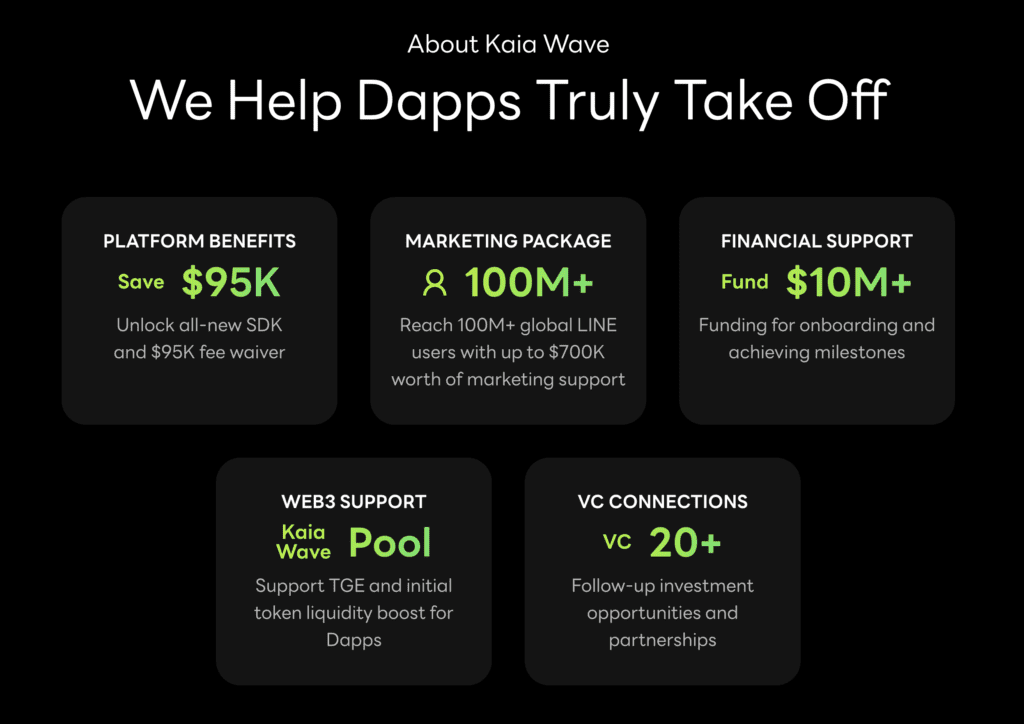
Kaia Waive value proposition – Source: Kaia
Alongside its mainnet debut, Kaia recently launched Kaia Wave: A flagship initiative built in collaboration with LINE NEXT to accelerate consumer adoption across Asia through a distribution-first approach.
At its core, Kaia Wave is a Web3 builder program that synergises LINE’s vast regional presence with Kaia’s modular blockchain stack, enabling developers to build and launch Mini Dapps directly within LINE Messenger via the newly released NEXT WEB SDK. This unlocks immediate access to millions of users across Japan, Taiwan, Thailand, and Indonesia—removing friction from onboarding and reducing time-to-market for Web3 products.
Completing the rest of the support initiatives, Kaia Wave serves as a powerful complement to final go-to-market distribution flywheel via offering builders plug-and-play access to Asia’s largest messaging ecosystems. By combining robust development support with seamless Web2-native distribution, Kaia’s consumer-first strategy is already demonstrating strong network effects at scale.
Kaia Wave Growth Highlights: Converting Distribution into Real Economic Value
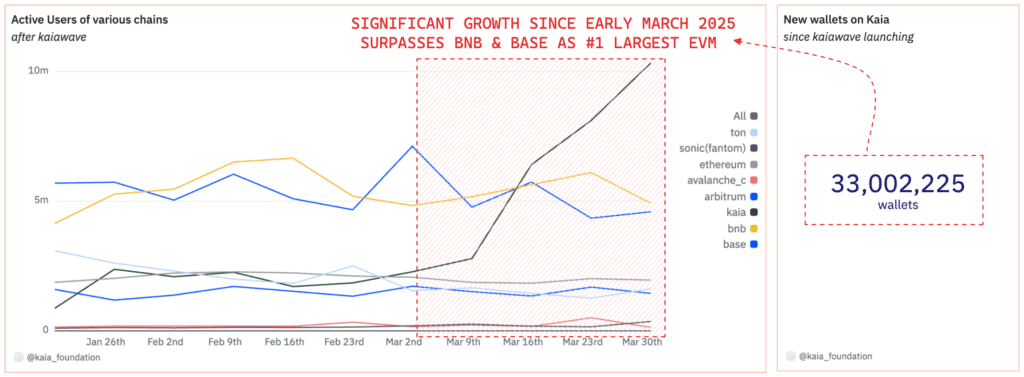
Kaia Growth Statistics – Source: Kaia Foundation Dune Dashboard
Since the launch of Kaia Wave, the network has demonstrated exceptional traction—validating its role as a high-performance, consumer-grade Web3 platform built for scale:
- 33M total wallets onboarded
- 1st largest EVM chain by active user count
- Consistent surge in daily active users (DAU) since mid-February 2025, outperforming most L1s and L2s
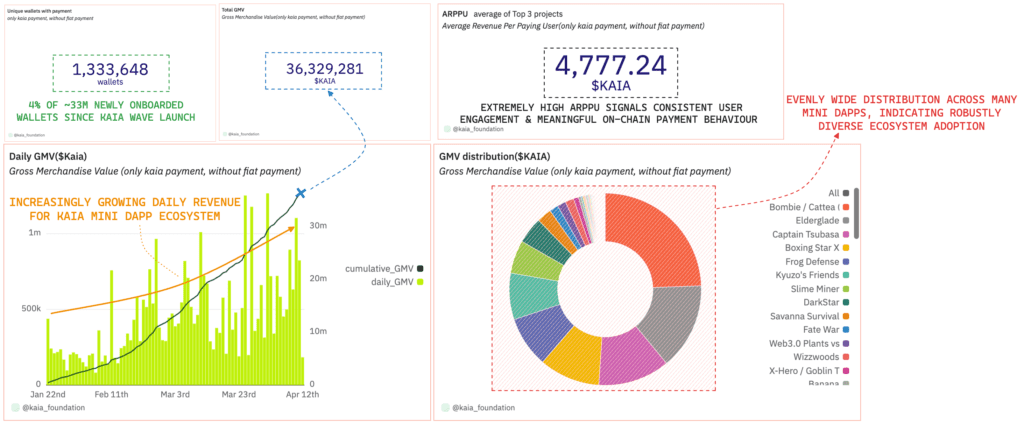
Kaia GMV & APPRU Statistics (exc. off-chain fiat payments)- Source: Kaia Foundation Dune Dashboard
While top-level metrics point to a highly successful campaign, the true strength lies in the payment layer metrics. Even without accounting for off-chain fiat flows, on-chain payment data alone signals strong user intent, meaningful utility, and high retention:
- $36.3M GMV in $KAIA processed across Mini Dapps, reflecting robust on-chain payment activity
- Evenly distributed revenue across numerous Mini Dapps, highlighting diverse and healthy ecosystem participation
- 4774.2 $KAIA ARPPU (average revenue per paying user) across the top 3 projects, indicating high-value, repeat usage
- 4% conversion rate from total user base, with over 1.33M active paying users
These data points highlight Kaia’s ability to convert vast distribution into tangible economic activity, delivering real product-market fit through a frictionless, mobile-first Web3 payment layer embedded directly in LINE and Kakao—the two most entrenched messaging superapps across Asia.
Holistic Support: Retrospective Ecosystem Growth

Kaia Past Grantees – Source: Kaia
These four initiatives collectively establish a holistic support framework aimed at building a vibrant financial layer while activating a self-sustaining flywheel. By aligning incentives across builders, infrastructure providers, and users, Kaia is strategically positioned for scalable and sustainable Web3 expansion. The effectiveness of this approach is already evident where past grantees in 2024 have been instrumental in strengthening the network’s core infrastructure, liquidity base, and application layer.
$KAIA Tokenomics & Strategic Funding Framework
At the core of Kaia’s sustainable ecosystem lies a tokenomic model designed to reward value creation and maintain long-term network health. $KAIA serves as the native token used for transaction fees, smart contract execution, and validator incentives—ensuring both functional utility and economic security.
Ecosystem-First Funding Structure
To align incentives across all ecosystem stakeholders, Kaia employs a strategic funding model in which 50% of block rewards are distributed to validators and stakers, while the remaining 50% is split equally between two dedicated growth funds:
- Kaia Ecosystem Fund (KEF): fuels developer incentives, ecosystem onboarding, and strategic investments.
- Kaia Infrastructure Fund (KIF): supports core R&D, protocol operations, and early-stage partner acceleration.
This dual-fund structure ensures that both technical infrastructure and on-chain activity are continuously nurtured. Transparent governance through the Kaia Governance Council (GC) and public forums like Kaia Square reinforces accountability—creating a feedback loop where network usage, utility, and token value drive ecosystem expansion.
Together, $KAIA and its funding framework power a self-sustaining flywheel of participation, innovation, and long-term growth.
Risks & Challenges Ahead
While Kaia holds significant promise in leading the next wave of Web3 adoption across Asia, it is not without risks. These challenges stem from both legacy issues inherited from its predecessor chains and broader structural or market-specific considerations:
Centralization & Legacy Perception
Kaia’s foundation, originally built on Klaytn, has historically faced criticism for its centralized validator structure. This reputation, compounded by a lack of sufficient decentralization, remains a reputational overhang, particularly among communities who prioritize permissionless and decentralized design.
Security Incidents: Orbit Bridge Hack
In January 2024, Orbit Bridge, an external cross-chain bridging service integrated with Klaytn, suffered an exploit resulting in a loss of over $81.5 million. While the incident was not due to vulnerabilities within Klaytn’s core infrastructure, it was nonetheless a significant event that affected user confidence and raised concerns around third-party dependencies.
Market Perception & Global Penetration Risks
Despite strong user bases in Japan, Korea, and Thailand, the LINE and Kakao ecosystems are primarily localized within Asia. Compared to global platforms like Telegram (The Open Network), this regional focus poses limitations on global market penetration and brand recognition especially among crypto-native audiences in the West.
Additionally, Kaia has yet to gain meaningful crypto-native mindshare among web3 communities and broader developer ecosystem. Much of its early branding and marketing have leaned toward Web2-style campaigns, which may not resonate with the fast-moving, open-source ethos of Web3 builders and communities.
Regulatory & Legal Headwinds
Kaia’s web3 partnership with LINE NEXT, a publicly listed entity, may introduces heightened regulatory exposure and operational bureaucracy, potentially slowing down decision-making and reducing the agility often required in fast-moving Web3 environments.
Product Limitations: Lack of On/Off-Ramp Integration
Currently, Kaia lacks seamless on/off-ramp integrations directly within its messaging superapps (LINE & KakaoTalk). For mass user onboarding, especially retail users unfamiliar with blockchain tools, the absence of intuitive fiat-to-crypto solutions could limit frictionless entry into the ecosystem.
Closing Remarks
Kaia sits at the convergence of Asia’s most powerful digital distribution rails and a purpose-built, developer-first blockchain infrastructure. Its dual advantage via direct integration into LINE and KakaoTalk, and a high-performance, EVM-equivalent modular chain offers a rare combination of user accessibility and technical scalability. With a thriving multi-sector ecosystem spanning DeFi, RWAs, gaming, and Mini Dapps, coupled with a deeply strategic funding framework, Kaia has engineered a flywheel where network usage drives value, and value reinforces further growth.
From empowering developers with low-friction tooling and onboarding to embedding Web3 functionality into apps used by over 250 million people, Kaia is not just building like any other blockchain; it’s actively shaping Asia’s most adopted blockchain economy.
Authors: @0xCheeezzyyyy, Memento Research
This report was written in partnership with Kaia DLT Foundation. This report has been prepared for informational purposes only. It does not constitute investment advice, financial advice, trading advice, or any other sort of advice, and you should not treat any of the report’s content as such.
